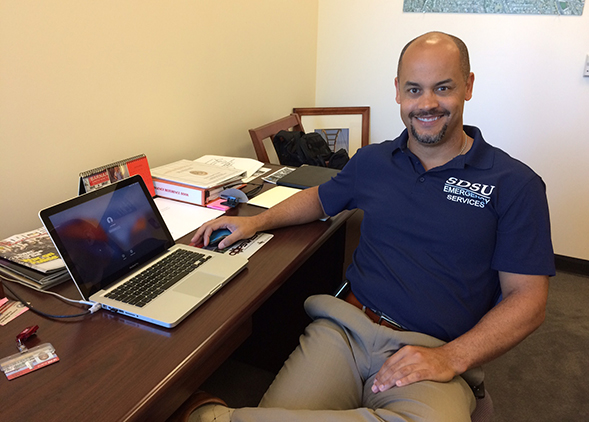Preparing for Emergencies
Former SDSU Chief of Police Lamine Secka now heads SDSUs emergency preparedness efforts.

That’s where SDSU’s Emergency Services comes in.
Led by former SDSU Chief of Police Lamine Secka, Emergency Services is responsible for campus emergency preparedness, such as emergency operation plans and communication, the cardiopulmonary resuscitation (CPR)/automated external defibrillator (AED) program, technology integration, faculty and staff training, and campus drills.
Previously an auxiliary responsibility, Emergency Services now has a full-time university employee heading the department along with four interns.
“I think it’s something important for the university, especially one of our size,” Secka said. “A lot of people are unaware the university has taken steps to prepare for emergencies.”
In his new role, Secka draws from the experience he gained while serving as SDSU’s chief of police for more than 10 years.
“Being a police officer means you basically are dealing with a series of mini-emergencies every day, so you quickly learn how to triage and determine a proper response,” Secka said. “Working with so many different people and departments gave me the contacts necessary to help prepare the campus for emergencies.”
His time as chief of police also gave Secka experience dealing with large-scale incidents on campus, including flooding at the University Towers residence hall and a bomb scare at then-Cox Arena during the 2006 NCAA Men’s Basketball Tournament. No device was found, but the arena had to be evacuated, delaying the game.
Since starting the position in May, Secka has been trying to figure out the security needs of the campus. He has focused on creating trainings for faculty and staff, developing a new emergency preparedness training class and student outreach through social media and emails.
As a way to prepare Aztecs, Emergency Services is offering a series of emergency preparedness events throughout the 2016-17 academic year, including a CPR/AED training on Nov. 15. These free events are open to SDSU faculty, staff and students and will cover a range of life-saving topics and skills.
SDSU Alert
Secka said the best way students, faculty and staff can prepare for emergencies is by signing up for SDSU Alert. In the event of a campus-wide emergency or health and safety concerns, SDSU Alert will send a text message to subscribers that notifies them of the situation and provides suggested measures they can take.
Students can register for SDSU Alert by signing into the SDSU WebPortal and adding their phone number.
The Great California Shakeout
Secka also oversees the Great California Shakeout. The nationwide event is scheduled for Thursday, Oct. 20 for Earthquake Awareness Month.
“Earthquakes are obviously a fairly big deal here in California,” Secka said. “We have a lot of out-of-state students who may have never experienced an earthquake before and the first time you’re in one, it can be unsettling.”
SDSU holds several emergency drills throughout the year, but Secka hopes to make the Great California Shakeout more engaging and informative for students by bringing an earthquake simulator trailer to campus.
During the shakeout, which begins at 10:20 a.m., campus emergency communication resources, including SDSU Alert, will be tested.



